In today’s Patreon-fueled shout-out: As we head into summer and the weather heats up, your local energy nonprofit, LEAP, wants you and yours to keep cool. LEAP offers FREE home weatherization to income- and age-qualifying residents. If you’re age 60 or older, or have an annual household income of less than $75,100, you may qualify for a free energy assessment and home energy improvements such as insulation and air sealing. Sign up today to lower your energy bills, increase comfort, and reduce energy waste at home!
On today’s show:
Updates on capital projects and cybersecurity from the Rivanna Water and Sewer Authority
A look at how the pandemic affected transportation behaviour
And the Jefferson Area Regional Transit Partnership discusses ways to get a better system by connecting various moving parts
Over three quarters of a million Virginians on Medicaid now have access to mental health and dental benefits. Governor Ralph Northam marked the occasion on July 1 while launching a new medical and dental center in Richmond. The change came in the form of an increased line item in the budget, which went into effect on yesterday. Medicaid members are now eligible for three cleanings a year as well as preventive care. The benefits are administered by DentaQuest, who can be reached at 1-888-912-3456 or visiting dentaquest.com. (press release)
The Board of Directors of the Rivanna Water and Sewer Authority (RWSA) met virtually on June 22. The RWSA builds and maintains the infrastructure that treats drinking water and processes wastewater in the various urban locations. That takes a lot of money, and there are a total of 54 projects in the agency’s capital improvement program over the next five years, at a cost of $170.1 million. But planning is also underway for projects that will be built after that time. (CIP highlights)
“The theme in our infrastructure and master planning you may note is pipelines,” said Bill Mawyer, the executive director of the RWSA. “We’re working on a central waterline that is going to largely go through the center area of the City of Charlottesville.”
A route has been identified for this project, and a cost-share allocation between Albemarle and Charlottesville has been discussed. The current capital program does include about $43 million for a new waterline between the Ragged Mountain Reservoir and the Observatory Hill Water Treatment Plant. That amount includes an upgrade of the water treatment plant that will increase its capacity to 10 million gallons a day.
The RWSA is still working to secure easements for a nine-mile pipeline to connect the Ragged Mountain and South Fork reservoirs. The project has a cost estimate of $80 million and has a current estimated completion date of 2033.
Another project that needs an agreement between Albemarle and Charlottesville is the replacement of the Schenk’s Branch interceptor. That’s an aging sewer line for which the first phase has been completed. The hold-up is the project’s alignment, which can either go on city property underneath McIntire Road south of Preston Avenue, or it can go on land owned by Albemarle County at its main office building. The RWSA’s monthly update on project has more information about the nearly $4 million project.
“Following pipe alignment determinations, the design plans will be updated, and the construction approach will be coordinated with a City project planned for the same general area,” reads the update.
The Board also got an update on security issues from the RWSA’s information systems administrator.
“Cyber-attack is the number one threat right now to our water infrastructure,” said Steven Miller.
It’s been nearly two months since a ransomware attack led to the shut-down of the Colonial Pipeline, leading to temporary fuel shortages in Virginia and other southern states. In February, a water treatment plan in Oldsmar, Florida was attacked by a hacker who sought to increase the levels of sodium hydroxide in order to poison people. That attack was stopped by monitoring by an employee. (Industrial Defender article)
Miller described the vulnerability that was exploited.
“Somebody left a remote access program on a machine and just left it sitting there and the operator’s password was acquired somehow and they were able to break in,” Miller said.
Mitigating tips include requiring multifactor authentication and backing up critical systems so they can be replaced if access is shut down through a ransomware attack. Miller said there are several layers of protection.
“So our first layer basically is physical,” Miller said. “We lock our water plants. We don’t just let people walk up to computers and use them.”
Other layers include camouflaging the RWSA networks through the next generation of firewalls.
“That software will also allow us to do something called geo-fencing which allows us to block all traffic from a specific area,” Miller said. “There’s really no reason we should have any traffic going to or from China.”
Next, the RWSA got an update on the federal and state permits required to draw water from the natural environment for urban water supply. The permits issued by the Virginia Department of Environment Quality and the U.S. Army Corps of Engineers expire in 2023 and will need to be reviewed. Jennifer Whitaker is the RWSA’s chief engineer.
“We luckily submitted our permit for the urban system in May of 2021 and are working our way through the process,” Whitaker said.
Since the last permits were issued, there’s a new dam at Ragged Mountain and the upgrade of two water treatments are underway. Future elements in the water supply plan include the construction of the South Fork to Rivanna waterline, the eventual raising of the water level at Ragged Mountain, and the decommissioning of the North Rivanna water treatment plant.
There are separate urban water systems for Crozet and Scottsville, as well as Glenmore.
The RWSA Board will next meet virtually on July 27 shortly after the meeting of the Rivanna Solid Waste Authority.
The pandemic affected how Americans traveled, with fewer vehicle miles traveled at a time when people were asked to stay at home as much as possible. The Commonwealth Transportation Board had a briefing on the numbers at their meeting on June 22 from Laura Schewel, the chief executive officer of StreetLight Data. (view the presentation slides)
“Everything that moves these days has some sort of technology on board to help measure it,” Schewel said. “It can be the geolocations in your phone, connected car data, data from car fleet management systems.”
StreetLight takes that data and analyzes it to describe how people are using roads across the whole country. Nationwide, vehicle miles traveled (VMT) in urban communities was at 60 percent of normal levels in April 2020 at the height of the lockdowns. The decrease was not as high in rural counties.
“Urban areas saw far more VMT decline and still haven’t recovered to the same level as the more rural and suburban counties,” Schewel said.
Schewel said while VMT is back up, there is evidence congestion is down in part to more people driving outside the traditional peak hours.
“We’re using our existing assets more evenly and that means we’re using our existing assets better,” Schewel said. “And that may mean that in some areas, we have reduced the need for road expansion or new roads because we’re doing a better job of using the roads we have.”
Schewel said better data may help transportation planners make better decisions about what might be needed in the future and that more time and data collection is needed.
“I think for the future, or really right now what we need to is to measure, we need to predict, but I don’t think we should make a prediction,” Schewel said. “We need to predict in ranges because we know there is uncertainty and we know things can change. We need to predict a range of outcomes.”
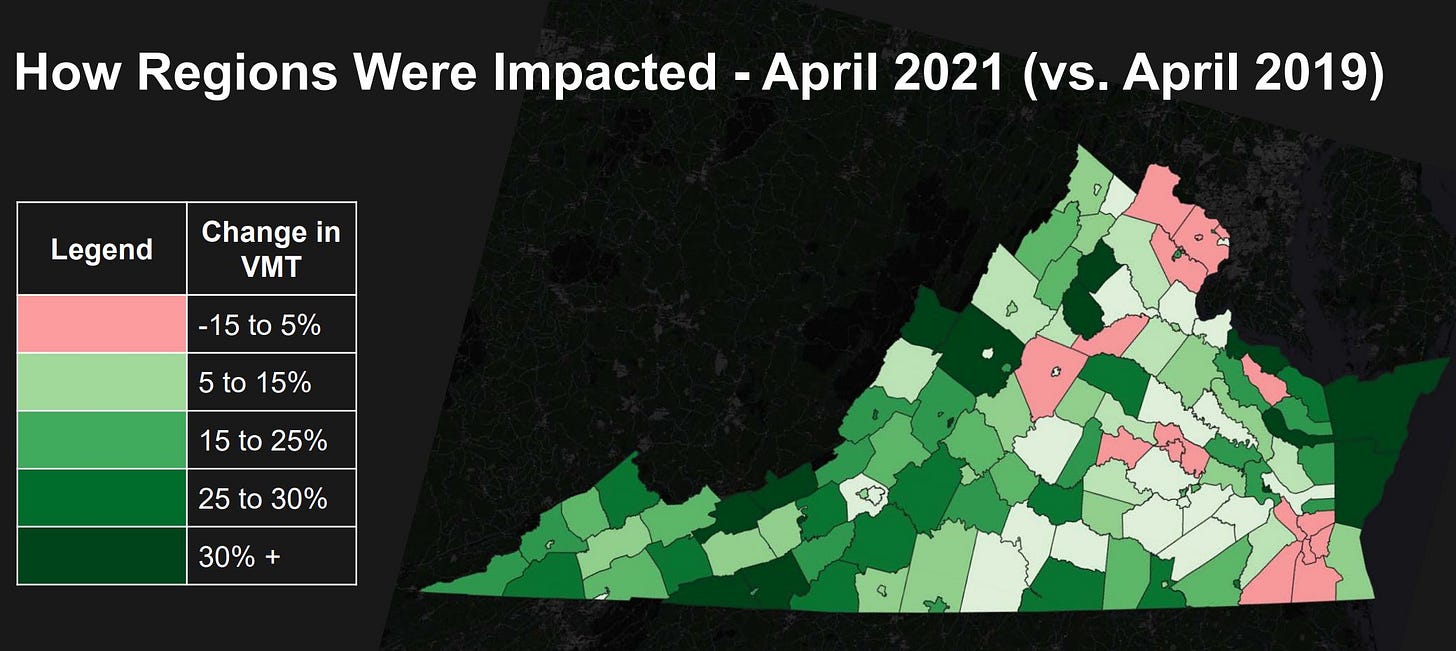
The Virginia Department of Transportation’s traffic division uses 512 counting stations to measure traffic volumes mostly on major highways. Engineer Mena Lockwood said Virginia saw a sharp decline in VMT in the early days of the pandemic but there has been a rebound.
“Since then we’ve been relatively steady and over the last couple of months we’ve actually had our traffic at above typical conditions and the all vehicle traffic has just been below typical conditions.”
Lockwood showed data that indicate that congestion in Virginia’s metropolitan areas is beginning to return to pre-pandemic levels. Several members of the CTB noted that this is the time for employers to consider incentive programs for teleworking and other programs to reduce vehicle miles traveled.
Another factor in the fall could be the full return to in-person school. Mary Hynes represents the Northern Virginia District on the CTB and she said localities need to be prepared.
“I’m a little worried about that, particularly in the really urban places, that we’re just going to have traffic jams beyond believe in September all about taking kids to school,” Hynes said.
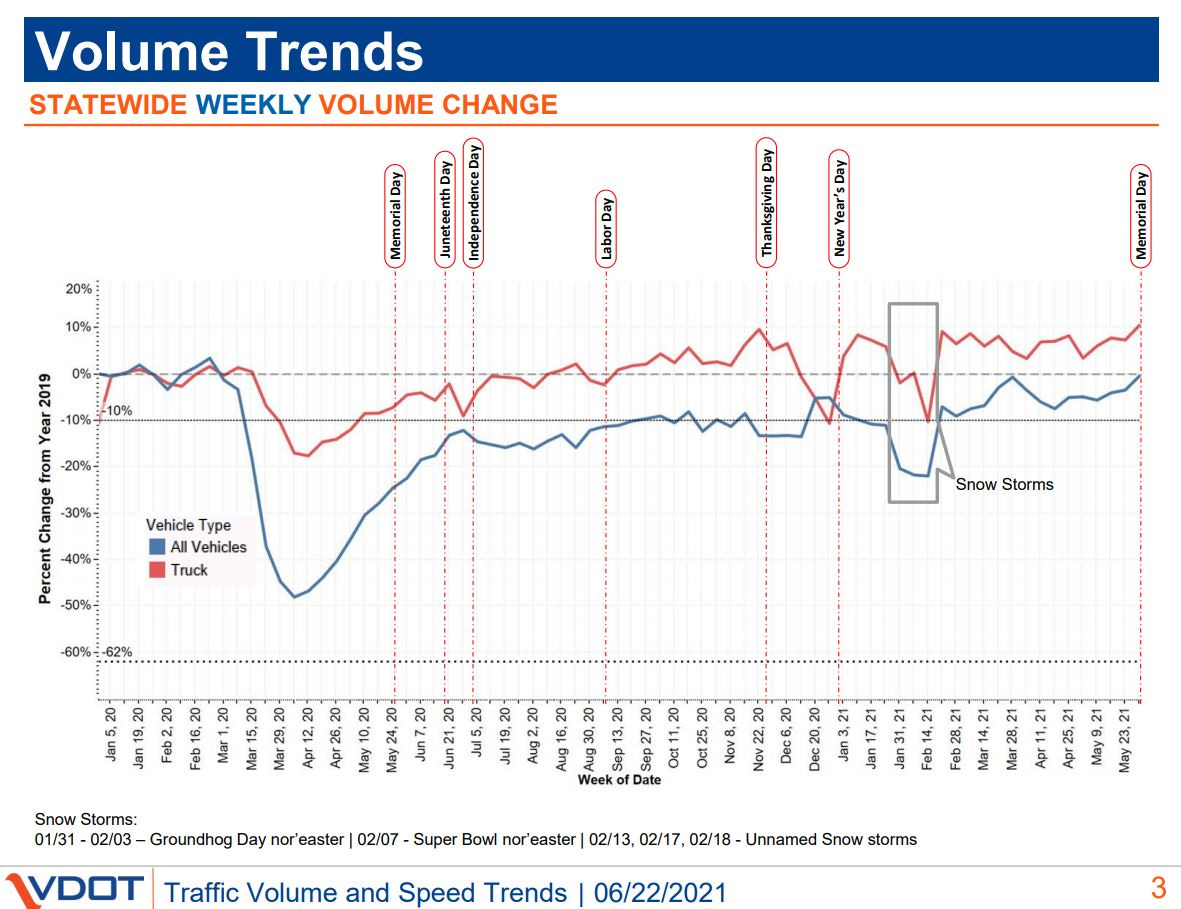
You’re reading Charlottesville Community Engagement and it’s time for another reader-supported public service announcement.
The future of passenger rail in Virginia got a lot more brighter this year as the Commonwealth of Virginia signed agreements with CSX to purchase hundreds of miles of railway corridors for three billion dollars. Virginians for High-Speed Rail are holding a transportation town hall on July 15 at 1 p.m. on the “True Story of the Virginia-CSX Deal: Lessons Learned and the Future of Passenger Rail.” Virginia Transportation Secretary Shannon Valentine and Amtrak President Stephen Gardner are the speakers. (register here)
If you’re interested in driving less, and you want to know what’s happening to improve transit, a good place to start is the Jefferson Area Regional Transit Partnership. The group consists of representatives from Charlottesville Area Transit, Jaunt, and the University of Virginia Transit Service, as well as elected and appointed officials. It’s also a place where people can comment on transit issues. One speaker at the June 24 meeting was Ethan Heil, who decided last year to get more involved.
“Last September I was excited to hear my appointment to the CAT Advisory Board,” Heil said. “Unfortunately since then I haven’t received any follow-up communication.”
Heil said he understood the body might not have been a priority during the pandemic, but that the advisory board should play a role going forward.
“I’m hopeful and respectfully request that we could find an opportunity to reengage the CAT advisory board,” Heil said.
Council discussed whether to keep the CAT Advisory Board as an entity last October when they reviewed the status of various appointed bodies. The Board has not met since the pandemic began.
At the end of the meeting, City Councilor Lloyd Snook said Council considered the fate of the CAT Advisory Board last October.
“We basically decided at that point that there really wasn’t a lot of reason why the CAT Advisory Board should be sort of a Council-level appointment,” Snook said. “It ought to be something that worked directly with Garland [Williams] and the transportation piece more directly rather than have us involved.”
Garland is Garland Williams, the manager of CAT. He said the advisory board is important, its its function needs to be studied.
“I think it needed to be looked at and I asked for your authorization to hire a consultant to look at what the CAT advisory board does and then bring back a recommendation to Council sometime this year or early next and you authorized me to do so,” Williams said.
One item on the partnership’s agenda was new guidance on getting assistance from VDOT staff for Smart Scale projects that seek to move more people onto to transit and other multimodal solutions. Chuck Proctor is an engineer in the Culpeper District.
“We can help you develop sketches for infrastructure improvements, if you wanted to put out a bus pull out or if you’re going to be doing bus stops,” Proctor said. “Even bike-pedestrian facilities to and from a transit stop.”
This year, the Thomas Jefferson Planning District Commission succeeded in securing $3.38 million in Smart Scale funding for a park and ride lot in Exit 107.
That would be on the route of the Afton Express service between Staunton and Charlottesville that is slated to start in September. The next deadline for the next Smart Scale cycle is not until the summer of 2022. Transit agencies can make their own applications.
Proctor said there are efforts to find a location for a park and ride lot on Pantops. There had been one at the Pantops Shopping Center.
Supervisor Diantha McKeel said she wanted to know more information about how people use park and ride lots, given the rising cost of land in the community.
“We don’t want to go out and take good valuable land or space and end up with, I mean we just need to know what we’re doing before we go ahead,” McKeel said.
Becca White, the director of parking and transportation at the University of Virginia, said park-and-ride has to be part of a coordinate strategy in order for it to work.
“It’s not park and ride for park and ride’s sake,” White said. “It has to be the right amenities. It has to be lighted properly. It has to have waiting areas. It has to be linked to either transit or car pool trips. It can be very successful but it’s not a park and ride for park and ride’s sake.”
CAT is studying possible locations for a park and ride lot on U.S. 29 in Albemarle County’s northern growth area. CAT Director Garland Williams said such a facility would be ideal for people driving to the University of Virginia.
“It would also add a hub for transit where you would have dedicated restrooms for our facilities moving forward,” Williams said.
The TJPDC is also studying expanded service in Albemarle’s northern growth area. The first round of public engagement efforts should begin in July.
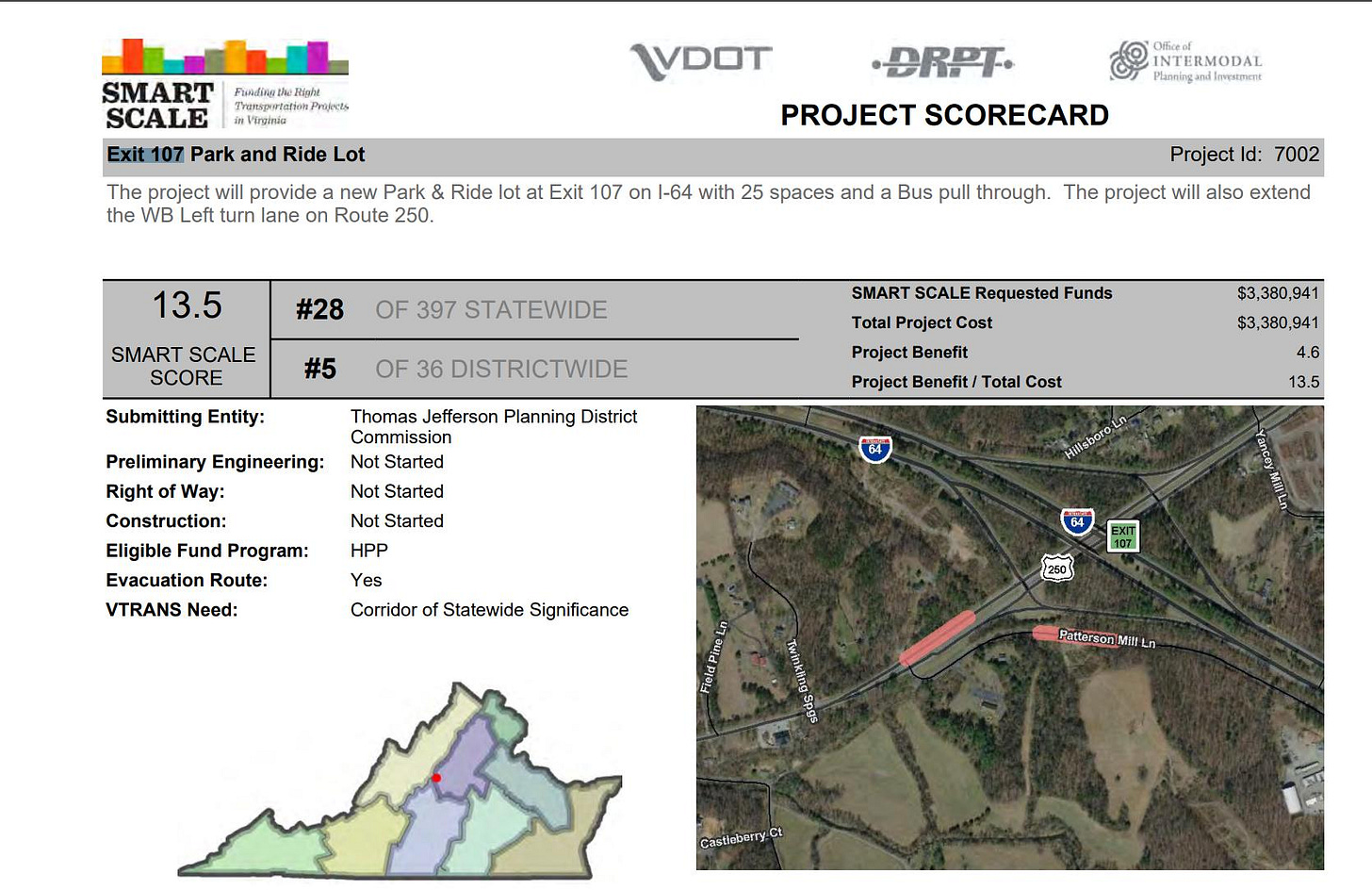
One change that will happen in the short-term is that CAT buses will no longer travel through the Rio Hill Shopping Center. Williams told the partnership that the property owners asked for the stop to be removed.
“Their reasoning was the shopping center will be undergoing a renovation of the storefronts and the current bus route will not work with the vision of the shopping center,” Williams said.
The shopping center would still be served, but the buses will not travel on the Rio Hill Shopping Center property. (learn more about the renovation in the February 6 CCE)
Toward the end of the meeting, Jaunt’s planning manager Steven Johnson posed an interesting question. Could bus stops used by multiple transit agencies be given names that could be shared?
“So that in our literature everybody is referring to the same stop by the same name,” Johnson said. “I think that would be a good thing for users of our systems.”
In June, City Council approved an appropriation of federal funding for Charlottesville Area Transit to purchase eleven buses, all of which will be powered by fossil fuels. CAT is conducting a study on how to proceed. (read more in June 24 CCE)
But some area transit fleets have bought a few electric vehicles. Jim Foley, the director of pupil transportation for Albemarle County Public Schools, said his system applied to Dominion’s electric school bus program.
“I’m not sure we’ll get them, but we gave it a try,” Foley said. “We did go visit Louisa County who did get two of the electric buses and they love them, plus Dominion came out with a program to reimburse schools for fast-chargers which would save hundreds of thousands of dollars.”
Foley said he drove one of the vehicles and found it to be smooth and powerful.
Christine Jacobs, the interim director of the TJPDC, said she would convene a workshop of various stakeholders outside of a partnership meeting in order to discuss the issue.
“Just sit everybody at the table so we can all share all of the information that we have,” Jacobs said. “Results from studies that are being done, data on the different types of buses. I think it’s something that there’s a real momentum and a craving for us all to share information and make sure that we’re all on the same page.
Williams expressed caution about having community members decide what kind of buses to purchase.
“The community doesn’t get involved when you’re talking about the selection of fire trucks, or police vehicles, or any of the other vehicles associated so it’s a little interesting there’s a lot of concern about selection with individuals who have not run a transit system and do not have any information about running it and what it takes to make sure that I am going to be reliable.”
Williams said a study will soon get underway to determine the best pathway forward and to develop a plan to transition the fleet. In the meantime, he does not want his hands tied.
“I’m not going to be subject to a command telling me to buy an electric bus when I have no confidence that it’s going to work,” Williams said.
Finally today, as reported here before, route changes are pending for Charlottesville Area Transit. The information has been presented to the Regional Transit Partnership and the City Council, but this summer the public will get the chance to ask questions in two virtual meetings. (Council Briefed on Proposed Transit Changes, June 2, 2021)
Both the Connetics Transportation Group and the firm Kimley-Horn have as been working with Williams on the changes. Here’s Williams at a June 29 press briefing.
“When we went into the pandemic, there was concern like most transit agencies about how when we get out of the pandemic, what do we do the make the system better for all who use it?” Williams asked.
Williams said the route changes are intended to reverse a period of ridership declines that was happening before the pandemic. In 2013, CAT carried over 2.4 million riders a year, but that dropped to just over $2 million in 2018. Williams also acknowledged there are a lot of moving parts in transit at the moment.
“This is not the end-all to-be-all,” Williams said. “The region is doing a visioning study so this was designed as a temporary measure over the next couple of years while that study is done to prevent us from having continued rapid decline in ridership.”
In the current system, all but one of the CAT’s 13 routes goes to the Downtown Transit Station. In the changes, at least one route will be oriented north-south to travel between Stonefield and the Willoughby Shopping Center. Jim Baker is with the Connectics Transportation Group.
“We’ve proposed introducing some new crosstown service from south Charlottesville to U.S. 29 so no longer will you need to travel to downtown, transfer to a bus to continue up to U.S 29,” Baker said. “You can do all of that on the same bus.”
Another change is that CAT service would be extended to Mill Creek in Albemarle County. Service would also go through the South First Street public housing complex. Other routes would have Sunday service for the first time.
The two public meetings will be on Friday, July 16 at noon and Wednesday, July 21 at 6 p.m.
Before you go:
Thanks so much to everyone for their financial support. No pitch today. I just want to thank you for reading. As I said in the podcast, the fact that you’re reading this shows that you care about the future of our community. I do as well, and have dedicated my life to reestablishing my pathway as a journalist. As you celebrate with friends and family, please tell others about the work. I’m about to begin Year Two and would like to expand the audience! This work is free and the work is paid for by the quarter of the audience that’s decided to contribute. I’m grateful to everyone who thinks this work is worthwhile enough to keep going.
Thanks again,
Sean Tubbs, Town Crier Productions

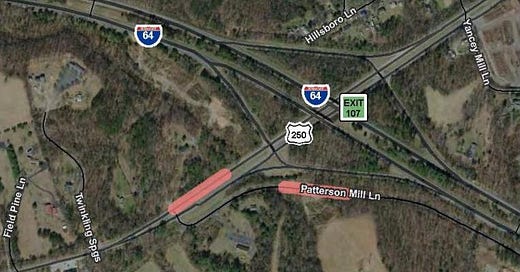













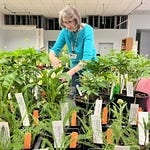
Share this post